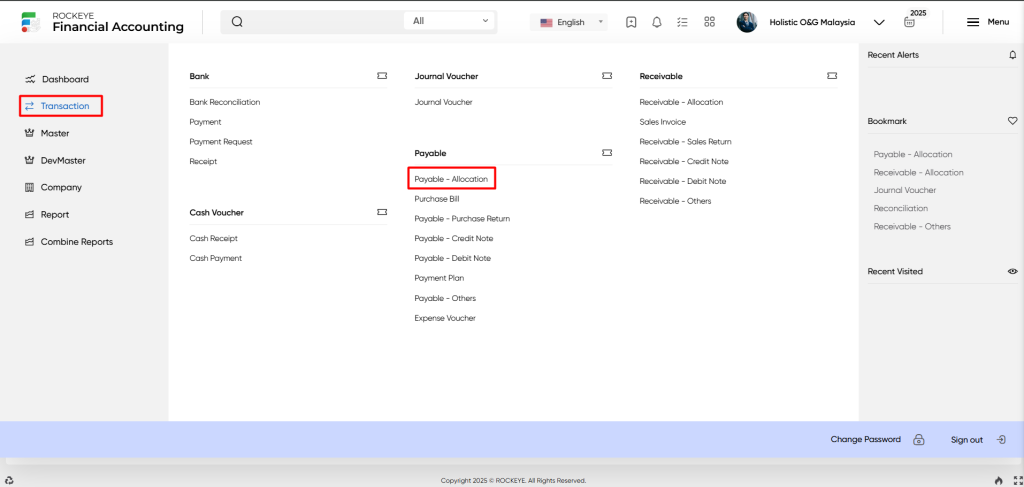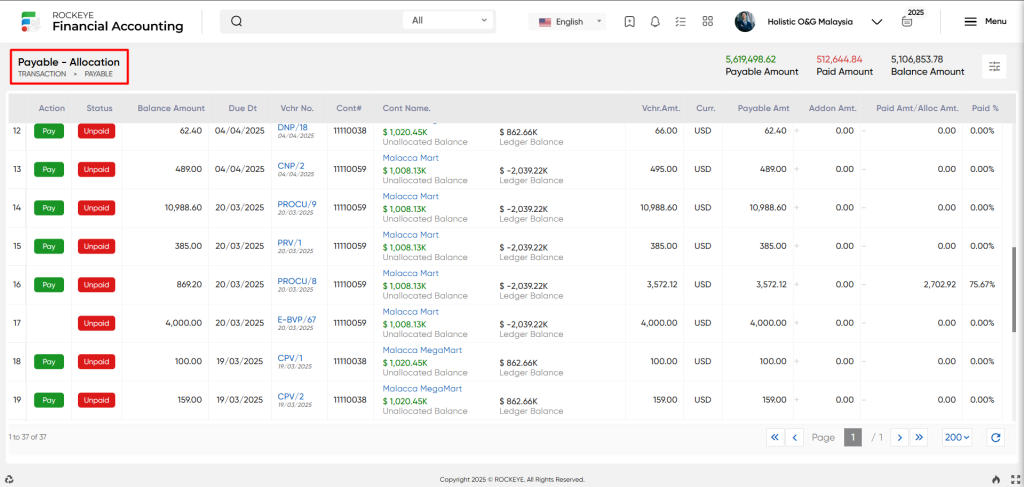Financial Accounting
Payable allocation
Introduction/Purpose:
Payable allocation is the practice of assigning a payment to specific liabilities or accounts payable in an organisation. This involves transferring funds from a payment to related invoices, bills, or obligations that must be settled.
Dependency:
- Accounts payable integration: The payable allocation technique is dependent on the payable allocation module being integrated with the accounts payable module. This interface ensures precise and efficient payment allocation by allowing for seamless data transmission and synchronisation.
- Payment prioritisation criteria: Some organisations may have special payment prioritisation criteria, such as distributing payments to the oldest bills first or prioritising payments based on essential vendors.
How To Navigate To Payable Allocation:
The navigation includes the following steps for viewing the payable allocation in the financial management system.

- Click on the transactions tab: The transactions can be accessed by clicking on the transactions tab on the side menu.
- Click on the payable allocation: The payable allocation can be accessed by clicking it from the payable section.
Listing:
A payment allocation listing in a financial management system is a feature that provides a list of all allocations.

- Users can view the following information in the payable allocation listing
- Voucher number
- Cont and cont name
- Voucher amount
- Currency
- Payable amount and addon amount
- Paid amount/allocated amount
- Balance and paid%
- Due date and days
- Action and status
User can perform the following actions
- Contact name: The “Contact name” refers to the filter payable allocations by the contact name related to the transaction.
- Contact code: The “Contact code” refers to the filtering of payable allocations based on the contact’s unique code or identity.
- Voucher Code: The “Voucher code” refers to the payable allocations filtered based on the voucher’s code or reference number.
- Voucher amount: The “Voucher amount” refers to the filter payable allocations depending on the total amount specified in the voucher.
- Paid Amount: The “Paid amount” refers to the filter payable allocations based on the amount paid for the voucher.
- Voucher Date: The “Voucher date” refers to the payable allocations filtered based on the voucher’s date.
- Status: The “Status” refers to the ability to filter payable allocations based on payment status, such as paid, unpaid, or partially paid.
- Paid %: The “Paid%” refers to the filter payable allocations based on the percentage of the voucher amount paid (e.g., less than 10%, less than 50%, etc.).
- Native currency or other currency: The “Native currency” or “other currency” refers to the filter payable allocations depending on the currency in which the transaction was performed. (e.g., in other countries, we have India and so on).
- Voucher type: The “Voucher type” refers to the filtering of payable allocations by voucher type, such as purchase vouchers, expense vouchers, credit notes, bank receipts, cash payments, and so on.
- All: The “All” refers to a view or option that allows users to see or show all payable allocations without applying any filters or restrictions.
- Refresh: The “Refresh” refers to an option that allows users to update or reload the payable allocation list with the most recent data.
- Export: The “Export” refers to the option that allows users to extract payable allocation data from the financial management system and save it in a format that can be used outside of the system.